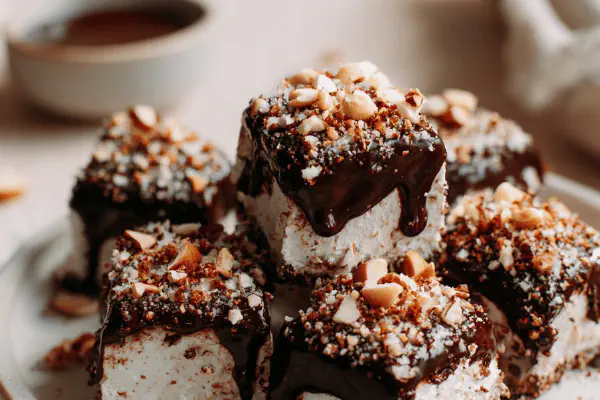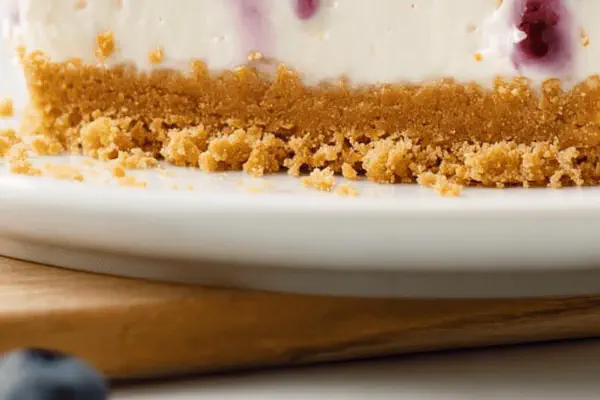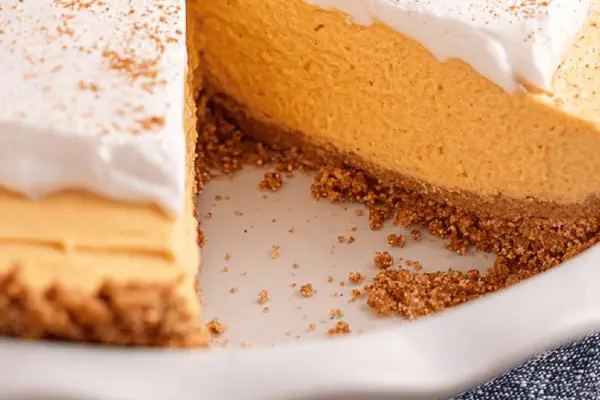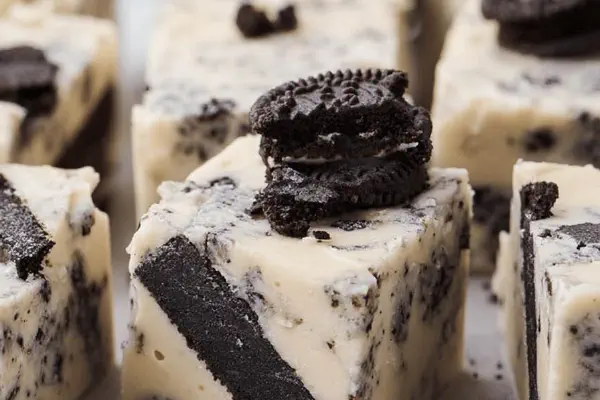Frozen Chocolate Bites

E
By Emma
Certified Culinary Professional
•
Recipe tested & approved
Dark chocolate melted gently, whipped cream folded in for airy texture, frozen then coated in glossy chocolate with hazelnut crunch. Swap nuts, swap oils to tweak texture and flavor. Tempering matters; gloss fades without it. Watch the cream—too stiff kills the melt, too soft no lift. Use spatula to fold, whisk to mix. Chill to firm but not icy solid. Dip quickly, coat evenly, freeze fast. Perfect on hot days or for sudden guests. Learn signs from sight and feel, not just stopwatch. Classic technique, with substitutions and tips for foolproof chilling and coating.
Prep:
25 min
Cook:
20 min
Total:
45 min
Servings:
4 servings
#chocolate dessert
#frozen treats
#French-inspired
#no-bake
#easy chilling
Dark chocolate melted slow. Cream whipped till clouds form. Fold gently—fold, fold, don’t smash the air out. Pour into mold. Stick inserted, wait hours, check firmness by poke. Freeze temperatures crucial; too warm and coating slips off, too cold and chew turns icy. Melt coating with olive oil, perfect balance between shine and snap. Dipped quickly, rolled in nuts, then back to freeze to seal crisp. Storage in freezer only keeps mousse texture lively. Tried this with pecans, coconut flakes, even freeze-dried berries for punch. Chocolate percentage tweaked; 70 percent works, 60 too sweet for my taste. Cream switching to coconut cream proved tricky—less stable but worth trial. This is technique, intuition, timing. Hot kitchen smells, sounds of whisk beating cream, chill time your friend.
Ingredients
- 120 g dark chocolate chips
- 220 ml heavy whipping cream 35%
- 280 g couverture chocolate chips
- 25 ml light olive oil
- hazelnuts chopped
About the ingredients
Chose dark chocolate with at least 70% for bitter balance but not harsh. Chips easier to melt evenly, no chopping needed. Heavy cream whipping needs cold cream, cold bowl preferably, for stable peaks—too warm foams collapse fast. For coating, using couverture chocolate ensures smooth melt and shine; olive oil added to thin melting and get that glossy finish without complicated tempering. Hazelnuts toasted till golden add crunch and a toasty aroma, fresh nuts or any similar texture nut or seed works. Coconut cream substitution requires patience: chill can, skim thick layer, whip gently, add stabilizer like powdered sugar to help hold peaks. Oil can be swapped with avocado or almond, depending on flavor profiles. Avoid butter; melts and fats differ. Molds—silicone is flexible and easy for unmolding; metal or plastic trays risk breakage of frozen mousse.
Method
Frozen Chocolate Bites
- 1. Chop dark chocolate if needed, melt gently in double boiler or short microwave bursts. Stir often – no scorching, just melted silky dark. Keep warm but not hot, watch for sheen losses.
- 2. Whip cream until soft peaks form—airy but still creamy, not grainy or butter-y. Should feel light yet hold shape for folding.
- 3. Pour about one-third of whipped cream into melted chocolate. Whisk vigorously right away to loosen chocolate, avoid clumps. Remaining cream folded in gently with a spatula, folding motion to keep bubbles intact. No overmixing or mousse turns heavy.
- 4. Spoon mixture into small silicone molds or ice cube trays. Insert wooden sticks or toothpicks to act as handles. Freeze solid about 3.5 hours (check hardness – surface no longer sticky, firm to touch).
Coating
- 5. Melt couverture chocolate with olive oil over gentle heat or microwave in short bursts, stirring between. Olive oil thins chocolate for smoother dip and shiny finish on temping slip-ups. Let blend cool slightly till shiny, fluid but not runny.
- 6. Remove frozen bites carefully from molds. Dip the rounded side into warm chocolate, then immediately roll in chopped hazelnuts, pressing lightly once tossed to make nuts stick. Excess chocolate will harden fast on cold surface.
- 7. Lay on parchment, return to freezer briefly to solidify coating. Store frozen to keep crunchy bite and preserves mousse texture inside.
Notes
- Chocolate/wax bloom happens if stored at fluctuating temps. Keep consistent cold. If chocolate dulls, re-temper by reheating gently with a bit of oil or cocoa butter. Nuts can be swapped for crushed freeze-dried raspberries or toasted coconut for twist.
- Whipped cream can be replaced with coconut cream for dairy-free version; adjust whipping time as coconut cream behaves differently. Dark chocolate percentage affects bitterness balance; 70% recommended but adjust to taste.
Cooking tips
Melting chocolate slower prevents scorching; stir frequently, watch sheen for readiness. Whipping cream—stop early when soft peaks form, stop before overwhip turns grainy. Folding chocolate and cream must be done with a spatula in gentle folding motions to keep mousse light. Pouring into molds uniform size matters for even freezing. Freeze time varies with freezer temp; test firmness every 3 hours. Melting coating chocolate with oil thins it; too much oil makes it runny, too little thick. Dip fast, coating firms immediately as mousse is icy cold—use room temp gloves or fork for handling. Nuts pressed gently to maintain crunch but stick well. Quick refreeze secures shell. Storage best done fully frozen; thawing causes gloss loss and texture change. If bloom appears, reheat chocolate coating slightly to restore sheen. Leftovers freeze well, but avoid refreeze-thaw cycles. Practice shows details in timing, temp, and folding technique make or break texture.
Chef's notes
- 💡 Melting chocolate slow, low heat, double boiler or short microwave bursts. Stir often to avoid scorch. Look for silky sheen before mixing. Warm but not hot; if too warm cream can break down once folded.
- 💡 Whip cream till soft peaks only. Too stiff kills melt texture, too loose means no lift. Feel for light hold, still airy clouds. Cold cream, cold bowl helps. Cream temp dictates mousse stability.
- 💡 First mix one-third cream straight into melted chocolate. Whisk fast to loosen, avoid clumps. Then fold remaining cream gently using spatula motions. No smashing bubbles. Folding keeps mousse light, air pockets intact.
- 💡 Freeze bites solid, check by touch—surface not sticky, firm but not rock-hard. Time varies; test after 3 hours. Uneven freezing causes coating issues later. Silicone molds help with smooth unmolds, metal risks cracks.
- 💡 Coating: melt couverture chocolate with olive oil low heat or bursts. Oil thins, adds shine, but too much makes runny coating. Rest mixture till shiny and fluid but holds shape on drip test. Dip quick, cold bites harden coating fast.
Common questions
How to know chocolate melted right?
Look for glossy melted sheen, no lumps or grainy patches. Stir often. If gloss dulls, temps too high. Cool slightly before mixing or it breaks cream.
Can I use other nuts?
Yes toasted pecans, coconut flakes, even crushed freeze-dried berries work. Texture matters. Press nuts gently after rolling to stick. Fresh nuts give crunch, toasted intensifies aroma.
What about cream substitutes?
Coconut cream okay but changes whipping time and peak form. Needs cold can, skim thick layer. Stabilizers like powdered sugar help hold shape. Less stable but doable with care.
How to store bites?
Keep frozen solid. Thawing causes bloom, dull coating, texture shifts. Repeated freeze-thaw kills mousse airiness. Wrap well, airtight to avoid moisture absorption and waxy bloom on chocolate surface.



